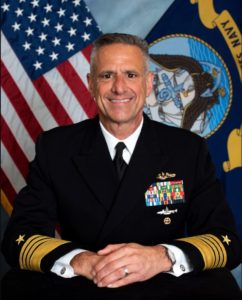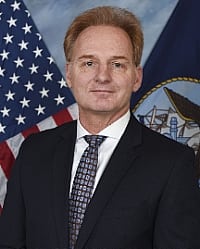A top Navy official said the service is unlikely to reach above 310 ships at current funding levels, let alone the congressionally-mandated goal of 355 ships.
“Will we get to 355 ships? I think with today’s fiscal situation and where the Navy’s topline is right now – we can keep around 305 to 310 ships whole, properly manned, properly maintained, properly equipped, and properly ready,” Vice Chief of Naval Operations Adm. Robert Burke said Friday at the Military Reporters and Editors (MRE) conference.
He said that while a 355-ship Navy is a great target “it’s more important that we have the maximum capability to address every challenge that we might face, given the resources that we do have.”

The 355-ship fleet idea started with an early 2016 Force Structure Assessment (FSA) that the increase was necessary to match growing Chinese and Russian naval forces (Defense Daily, Dec. 16, 2016)
The Navy is finishing a new FSA it is expecting to release next year. Burke said the service is in the “final stages” of the new report.
“Although I can’t tell you the details of what this new force structure assessment is pointing to, I will tell you that we’re doing some things differently here and I’m kind of excited about the approach that we’re using,” Burke continued.
Burke underscored the 310-ship count holds if the Navy’s budget topline funding does not increase above where it is now “and it is projected to remain for the rest of the future years defense plan. That’s about where we can get to and do it right in terms of man those ships, maintain them, and have all the coordinates for them and generate readiness.”
To reach 355 ships, Congress would need to increase the Navy’s topline, but Burke admitted several fiscal challenges coming together at the same time in all the services. He said the department is trying to recapitalize its strategic nuclear deterrent forces in the Columbia-class submarine, is conducting modernization efforts in other places like nuclear command and control, and is hardening systems from cyber attacks.
“So it’s almost a little bit of a perfect storm there when we also are trying to grow the fleet. And so we’re having those conversations as well. It’s not to say that we won’t get to 355, but some tough decisions will have to be made, some changes will have to be made in order to be able to fund going there, and we’re having those discussions right now,” Burke added.
Similarly, Secretary of the Navy Richard Spencer said at a Brookings Institution event last week that the future fleet may very well be smaller than 355.
“A 355-ship Navy is an important aspirational goal. But more important is ensuring we have the maximum capability to address every challenge we’re going to be facing,” Spencer said.
Also speaking at the MRE conference, Under Secretary of the Navy Thomas Modly said the 355-ship fleet is “going to be very, very difficult for us to do” based on that force structure and current budget topline.
“So we’re all sort of coming to this realization now that there’s a math problem that we need to try and solve. And we have to be creative about how we’re going to solve it,” Modly continued.
Modly said the Navy is working through several issues. “First of all, is the number 355 the right number? I don’t know. I suspect it’s probably more. It probably needs to be more than that. But the way we define a battle force ship we probably need to think about that differently as well. As technology advanced and we have the ability to have fairly large unmanned platforms out there that have significant lethality, do we include them in our ship force count? So we have to take a really hard look at what 355 means. If it’s the right number does it even matter what the number is? And what are we investing in for the future?”
He said this concept of ships is on his mind a lot and is coming to a head as the service considers the FY 2021 budget request, FSA, and what the Navy will invest in and divest from.
Burke said this new FSA is being done in two parts and it will be “completely integrated” with the Marine Corps while looking at naval power as a whole, so the future force structure can help the Navy meet national defense strategy objectives.

While historically the FSAs have conservatively relied on proven technology as well as current force structure and concepts of operation, the next report hedges on conservative estimates of new technology.
“We’ve made conservative estimates on what that will prove out and we’re aiming for the 2030 timeframe for what would our force need to be like.”
This means the Navy is accounting for unmanned systems, developmental concepts, Distributed Maritime Operations (DMO), the Air Force’s multi-domain command and control, and the Army’s multi-domain operations. “They all fit together in this future fight that we are envisioning.”
“So we’re responding to the call to move faster, to do things smarter, and not be afraid to do it differently if that is what it takes to prevail, in this really, what we see as a maritime century. And I think this force structure assessment will provide the basis to equip our future naval forces, make sure they’ve got the right capability and the right numbers to fully realize those concepts and meet the challenges of this complex competitive environment we’re in,” Burke added.
Congress put the 355-target into law, but cracks have been cropping up in how necessary and realistic that number is.
Last year, a Congressional Budget Office report said the Navy’s plan to reach 355 ships would cost a third more than the Navy estimated when adding in the full costs of shipbuilding like refueling nuclear-powered aircraft carriers or outfitting new ships with equipment pieces after being built (Defense Daily, Oct. 19, 2018). CBO also estimates future ships will cost more than the Navy projects, particularly future vessels like the post-Virginia-class attack submarine, SSN(X), and the future Large Surface Combatant (LSC) to succeed the Arleigh Burke-class Flight III destroyer.
The Navy’s FY 2020 30-year shipbuilding plan continued the projection for 355 ships, saying it could reach the number in FY 2034. However, it found the rising cost of manpower, operations, and ship maintenance means even after reaching the goal costs will continue to rise through 2049 to up to $55 billion in then-year dollars with a flat ship count (Defense Daily, March 21).
In March, Vice Adm. William Merz, then-Deputy Chief of Naval Operations for Warfare Systems (N9), told Congress the new FSA may not keep the fleet size constant but found it “highly unlikely to come up with a lower number based on the growing threat challenge” (Defense Daily, March 27).
In May, Merz reiterated he did not see the FSA fleet size falling, but said it may focus more on smaller surface combatants to be more reflective of the DMO and because the new guided missile frigate program is going well (Defense Daily, May 15).
Merz is currently the commander of the U.S. 7th Fleet.